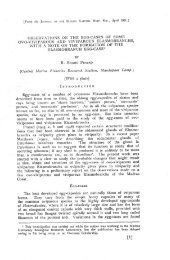PDF - Eprints@CMFRI
PDF - Eprints@CMFRI
PDF - Eprints@CMFRI
Create successful ePaper yourself
Turn your PDF publications into a flip-book with our unique Google optimized e-Paper software.
169<br />
We ha ve found no other coral which agrees better to our specimen than BOURNE's B. cumingii and<br />
SEMPER 's Rbodopsammia ovalis. After SEMPER the polyps are provided " mit gelben Tentakeln und<br />
brillant orangefarbenem Mund ". FRICKE described the colour of the polyps as yellow with red oral discs.<br />
Mater ial :<br />
Northern R. S. : HLM Fri 78-3 (Ras Umm Sidd, 138 mi·<br />
Dis t r ib uti 0 n : Red Sea ; Ceylon ; Philippines.<br />
Rem ark s : If our identification proves correct, this is the first record of the species from the<br />
Red Sea .<br />
The taxonomic position of Balanopbyllia is in a poor state. Many of the so-called species are described<br />
on the strength of a single or a limited number of specimens, and many are certainly only ecomorphs or<br />
geographical variants. A revision of the genus is most desirable .<br />
Genus Rbizopsa mmia VERRILL, 1869<br />
T Y pes p e c i e s : Rbizopsammia pulcbra VERRI LL, 1869.<br />
G e n e ric c h a r act e r s : Small colonies, formed by extra tentacular budding and by stolon-like<br />
expansions, from which new corallites develop. Septa according to POURTALES plan, no paliform lobes,<br />
columella spongy, wall porous.<br />
Rbizopsammia wettsteini new spec.<br />
(Plate 39. Figs. 1-4)<br />
We have two specimens before us , which we adjoin with some hesitation to the ge nus Rbizopsammia.<br />
Both are small colonies formed by extratentacular budding and with stolo ns bearing young corallites.<br />
The corallites are about 10 mm high, the calices are almost round, 7 to 10 mm in diameter, the<br />
largest calyx measuring 11.5 by 10 .5 mm . The corallites have a smaller diameter at their base.<br />
Columella loosely packed and spongy. Septa in four complete cycles, fifth and sixth cycle incomplete.<br />
Septa of the first two cycles almost identical, sloping downwards from the edge to the columella, which<br />
makes the calices appear wide and open. Edges of first two cycle septa irregularly dentate or fra yed, only<br />
in very few cases are the edges intact. Septa perforated. Sides covered with granules and striations vertically<br />
to edge. Septa of higher orders are even more irregularly frayed and perforated . The quarternaries<br />
unite beneath the short tertiaries and join the columella. Moreover, they are joined to the first and second<br />
septa at the upper margin of the calxy by a spongy network of septa fringes , which makes these twelve<br />
points appear thicker. This is particularly evident on the first cycle septa.<br />
Costae, especially in the upper part of the coraUite, not clearly visible with numerous granules, often<br />
forming reticular ridges, interspersed with numero us perforations.<br />
PW 73 614- 1 consists of a principal calyx with two secondary calices o n one side. Two ribbed stolons<br />
branch out from this colony, one of which has developed a daughter corallite at the end, the upper<br />
portion of which is missing. Some specimens of Polycyatbus [uscomarginatus settle on the substrate<br />
supporting the colony.<br />
PW 73 614- 2 is also a small colony comprising three corallites with two stolons, each with a small<br />
daughter coraHite.<br />
The most strik ing features of R. wettsteini are the porosity and sponginess of the coral and its wide<br />
open calices.<br />
Materia l:<br />
Gulf of Aqaba: Basel PW 73614-1,2 (Eilat).<br />
Rem a rk s : Rbizopsammia wettsteini is named after the late Peter WETTSTEIN, who collected<br />
corals in the Gulf of Aqaba as part of Prof. HOTTINGER 's work on Foraminifera in 1971 and 1973 . His<br />
accidental death occurred in December 1975 before he could complete t he identification of his corals.
















